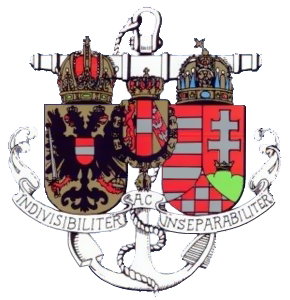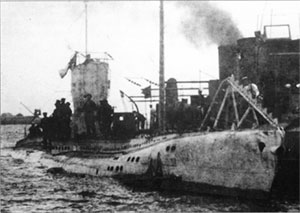Related Research Articles

The Austro-Hungarian Navy or Imperial and Royal War Navy was the naval force of Austria-Hungary. Ships of the Austro-Hungarian Navy were designated SMS, for Seiner Majestät Schiff. The k.u.k. Kriegsmarine came into being after the formation of Austria-Hungary in 1867, and ceased to exist in 1918 upon the Empire's defeat and subsequent collapse at the end of World War I.

The Austro-Hungarian Army or Imperial and Royal Army was the land force of the Austro-Hungarian Dual Monarchy from 1867 to 1918. It was composed of three parts: the joint army, the Imperial Austrian Landwehr, and the Royal Hungarian Honvéd.

The Type UB I submarine was a class of small coastal submarines (U-boats) built in Germany at the beginning of the First World War. 20 boats were constructed, most of which went into service with the German Imperial Navy. Boats of this design were also operated by the Austro-Hungarian Navy and the Bulgarian Navy. In the Austro-Hungarian Navy, it was called the U-10 class.
The Austro-Hungarian U-boat fleet was created in the decade prior to the First World War. They were built to a variety of designs, many under licence from Germany. They served throughout the war against Italian, French and British shipping in the Mediterranean Sea with some success, losing eight of the twenty eight boats in service in return. They were reinforced by the Imperial German Navy’s Pola Flotilla, mainly comprising coastal U-boats transported by rail from Germany's northern shipyards to the Austrian ports on the Adriatic Sea. Following the end of the war in 1918, all Austrian submarines were surrendered to the Entente powers, who disposed of them individually. As both Austria and Hungary became landlocked in the aftermath of the war, no Austrian or Hungarian submarines have been commissioned since.

SM UB-46 was a Type UB II submarine or U-boat for the German Imperial Navy during World War I. UB-46 operated in the Mediterranean and the Black Seas, and was sunk by a mine in December 1916.
The Type U 66 was a class of five submarines or U-boats operated by the German Imperial Navy during World War I. The class is alternately referred to as the U-66-class or the Type UD. The class was built by Germaniawerft of Kiel to their 506d design as the U-7-class for the Austro-Hungarian Navy. The five boats were sold to the Imperial Germany Navy at the beginning of World War I when it was thought impossible for the submarines to reach the Mediterranean for delivery to Austria-Hungary.

SM U-10 or U-X was the lead boat of the U-10 class of submarines for the Austro-Hungarian Navy during World War I. She was originally a German Type UB I submarine commissioned into the German Imperial Navy as SM UB-1.
SM U-69 was a Type U 66 submarine or U-boat for the German Imperial Navy during the First World War. She had been laid down in February 1914 as U-10 the fourth boat of the U-7 class for the Austro-Hungarian Navy but was sold to Germany, along with the others in her class, in November 1914.
SM U-67 was a Type U 66 submarine or U-boat for the German Imperial Navy during the First World War. She had been laid down in November 1913 as U-8 the second boat of the U-7 class for the Austro-Hungarian Navy but was sold to Germany, along with the others in her class, in November 1914.

SM UB-47 was a Type UB II submarine or U-boat for the German Imperial Navy during World War I. UB-47 was sold to the Austro-Hungarian Navy during the war. In Austro-Hungarian service the B was dropped from her name and she was known as SM U-47 or U-XLVII as a member of the Austro-Hungarian U-43 class.

SM UB-43 was a Type UB II submarine or U-boat for the German Imperial Navy during World War I. UB-43 was sold to the Austro-Hungarian Navy during the war. In Austro-Hungarian service the B was dropped from her name and she was known as SM U-43 or U-XLIII as the lead boat of the Austro-Hungarian U-43 class.

SM UB-44 was a Type UB II submarine or U-boat for the German Imperial Navy during World War I. UB-44 operated in the Mediterranean and disappeared in August 1916.

SM UB-8 was a German Type UB I submarine or U-boat in the German Imperial Navy during World War I. She was sold to Bulgaria in 1916 and renamed Podvodnik No. 18, and was the first ever Bulgarian submarine.

SMS Leitha or Lajta Monitor Museumship was the first river monitor in Europe and the oldest and also the only remaining, fully restored warship of the Austro-Hungarian Navy. Currently it is moored on the Danube in Budapest near the Hungarian Parliament Building as a museum ship.

The Yugoslav monitor Drava was a river monitor operated by the Royal Yugoslav Navy between 1921 and 1941. She was originally built for the Austro-Hungarian Navy as the name ship of the Enns-class river monitors. As SMS Enns, she was part of the Danube Flotilla during World War I, and fought against the Serbian and Romanian armies from Belgrade to the lower Danube. In October 1915, she was covering an amphibious assault on Belgrade when she was holed below the waterline by a direct hit, and had to be towed to Budapest for repairs. After brief service with the Hungarian People's Republic at the end of the war, she was transferred to the newly created Kingdom of Serbs, Croats and Slovenes, and renamed Drava. She remained in service throughout the interwar period, but was not always in full commission due to budget restrictions.

The Yugoslav monitor Sava is a Temes-class river monitor that was built for the Austro-Hungarian Navy as SMS Bodrog. She fired the first shots of World War I just after 01:00 on 29 July 1914, when she and two other monitors shelled Serbian defences near Belgrade. She was part of the Danube Flotilla, and fought the Serbian and Romanian armies from Belgrade to the mouth of the Danube. In the closing stages of the war, she was the last monitor to withdraw towards Budapest, but was captured by the Serbs when she grounded on a sandbank downstream from Belgrade. After the war, she was transferred to the newly created Kingdom of Serbs, Croats and Slovenes, and renamed Sava. She remained in service throughout the interwar period, although budget restrictions meant she was not always in full commission.

SMS Körös was the name ship of the Körös-class river monitors built for the Austro-Hungarian Navy. Completed in 1892, the ship was part of the Danube Flotilla, and fought various Allied forces from Belgrade down the Danube to the Black Sea during World War I. After brief service with the Hungarian People's Republic at the end of the war, she was transferred to the newly created Kingdom of Serbs, Croats, and Slovenes, and renamed Morava. She remained in service throughout the interwar period, although budget restrictions meant she was not always in full commission.

The Danube Flotilla was naval formation of the British Mediterranean Fleet from 1919 to 1926.
The history of the Serbian River Flotilla dates back to early 20th century, although its precursors originates as early as 16th century.
The Bombardment of Belgrade was an attack carried out by Austria-Hungary on the Serbian capital during the night of 28–29 July 1914. It is considered the first military action of World War I.
References
- ↑ "A-H Danube Flotilla". www.gwpda.org. Retrieved 2021-07-20.
- ↑ "Imperial Austrian-Hungarian Danube Flotilla". Feldgrau. 2020-08-04. Retrieved 2021-07-20.
- ↑ "A-H Danube Flotilla". www.gwpda.org. Retrieved 2021-07-20.
- ↑ "Imperial Austrian-Hungarian Danube Flotilla". Feldgrau. 2020-08-04. Retrieved 2021-07-20.